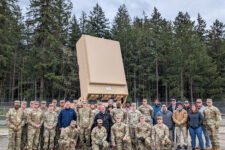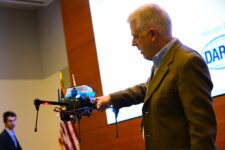
As part of its post-bankruptcy restructuring plan, Ligado has signed an agreement with AST SpaceMobile to lease some of its spectrum for satellite-to-phone communications. (Image: Getty)
WASHINGTON — Ligado Networks today announced it has filed for Chapter 11 bankruptcy and is putting in place a restructuring plan that the company says will reduce its current debt load of $8.6 billion to approximately $1.2 billion — in large part financed by a deal with satellite-to-phone company AST SpaceMobile.
In addition, creditors holding some 88 percent of the firm’s debt have agreed under the restructuring plan “to provide $115 million of additional incremental financing to fund Ligado during the restructuring process,” the Ligado press release explained.
The bankruptcy, filed in the US Bankruptcy Court for the District of Delaware, is itself not a surprise. The company has been signaling that might be an option since last year when it sued the Defense and Commerce Departments for allegedly “seizing” its L-band spectrum license.
That license was granted by the Federal Communications Commission (FCC) in 2020, but the DoD, Commerce and a number of other government agencies have been protesting the decision ever since, arguing that Ligado’s plan to use that spectrum for cellular communications rather than traditional satellite communications would dangerously interfere with GPS signals widely used by the military, commercial aviation and myriad other industries for positioning, timing and navigation. Ligado has contested that claim.
The deal with AST calls for the firm to lease 45 MHz of Ligado’s mid-band spectrum — the same spectrum at the center of the DoD controversy — for use by its satellites in low Earth orbit providing connectivity with cellular telephones. That was something of a surprise move for AST, according to veteran telecommunications consultant Tim Farrar.
“The transaction associated with [Ligado’s bankruptcy] is fairly unexpected, in terms of AST agreeing to lease their spectrum, because AST has been all about partnerships with cellular operators and using terrestrial spectrum … and building satellites to operate in lower frequencies,” he said. “It’s really a sort of 180 degree turn for AST to basically go and move to MSS [mobile satellite service] spectrum and move to these higher frequencies, where as they had said they were much better off with the low frequencies which were going to penetrate buildings.”
According to Ligado’s press release, AST “has agreed to provide Ligado, subject to certain conditions precedent, with approximately $113 million of AST SpaceMobile warrants, and usage rights payments to fund Ligado’s payments under certain spectrum agreements. Additionally, Ligado will receive economic participation in AST SpaceMobile’s direct-to-device business in the U.S. and Canada.”
For its part, AST in a press release today said the deal would help the company expand its services.
“Adding premium lower mid-band spectrum access in the United States to the AST SpaceMobile network gives us long-term access to a large block of a scarce resource, significantly enhancing our planned space-based cellular broadband offering,” said Abel Avellan, Chairman and CEO at AST SpaceMobile.
Farrar said the likelihood is that Ligado will “hive off” this part of its business as a sub-unit while keeping its one satellite in geosynchronous orbit active in order to maintain its spectrum license in order “to continue to make their lease payments to Viasat.”
According to the Ligado release, the company had been for the past year making an effort “to secure a comprehensive resolution with satellite communications company Viasat to restructure Ligado’s significant payment obligations to Inmarsat, which Viasat acquired in 2023.” Viasat had been planning to partner with Ligado on satellite-to-cell services.
Another Coming Twist With Trump?
Meanwhile, the company said it has no intentions of dropping its lawsuit against the federal government — which, if won, could also be a source of income to pay off debtors.
“Ligado will continue to vigorously prosecute its litigation against the U.S. government to enforce its constitutional right to just compensation for the government’s unlawful taking of Ligado’s licensed L Band spectrum,” Doug Smith, president and CEO, said in the firm’s press release.
But that effort is likely to come with a twist, said Farrar, who predicted that Ligado will also pursue an effort to come to an out-of-court settlement with the incoming Trump administration. During Trump’s first term, federal officials leaned strongly into efforts by the mobile telecom industry to take over spectrum traditionally used by government agencies and satellite firms for use by developing 5G networks. Indeed, Trump’s FCC Chair nominee, Brendon Carr, along with the rest of the FCC, in 2020 voted to support Ligado’s application, and he was a vocal supporter of opening up spectrum for economic benefits.
However, Farrar said that there are myriad complicating factors at play both with regard to the fate of the lawsuit and the conclusion of Ligado’s restructuring plan.
“The question is, is this new administration going to be willing to settle that lawsuit?” he asked. And that may depend, he added, on whether new Trump advisor Elon Musk “is going to weigh in as a example of this not being government efficiency at its finest? … The problem is if Elon Musk weighs in, because AST is obviously a competitor with Starlink, then all bets are off.”
At the moment Musk’s SpaceX, which operates the Starlink satellites, has been focusing on making alliances with terrestrial wireless providers for satellite-to-phone services, with an agreement already in play with T-Mobile. But as AST and others companies move to instead use spectrum allocated to satellite rather than wireless communications, SpaceX will need to decide whether it also wants to pivot, Farrar said.
Further, he explained that government agencies including the FCC have to approve the Ligado/AST deal. And that may be impacted by the fact that Commerce’s National Telecommunications and Information Administration (NTIA) on Dec. 17 opened a new study on potential interference from direct-to-device networks with GPS signals that has implications for the Ligado case. It is unclear when that study will be completed; industry representatives have until the end of this month to make initial comments on a series of NTIA questions.
For NTIA, which coordinates spectrum usage by federal agencies including by DoD, there is a conundrum at play with regard to the impending “direct to device” boom. On one hand, the Pentagon and other agencies are worried about GPS interference, but on the other hand, DoD in particular is itching to gain the benefits of secure satellite connections to phones and other handheld devices for use behind enemy lines.
“This is not something that is going to be solved in a few days or a few weeks. This is going to take months, if not even a year or more,” Farrar summed up.






















